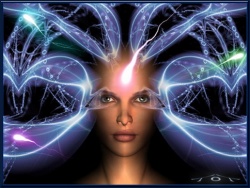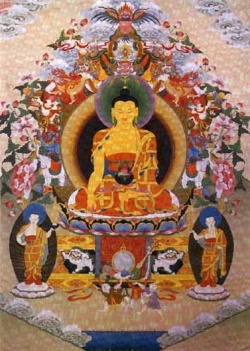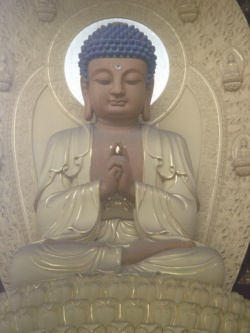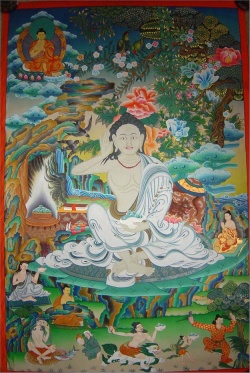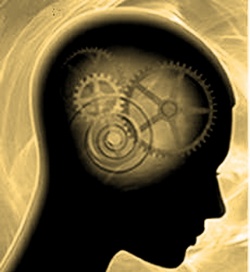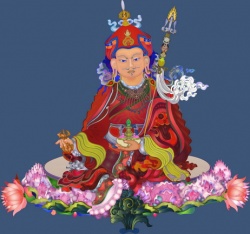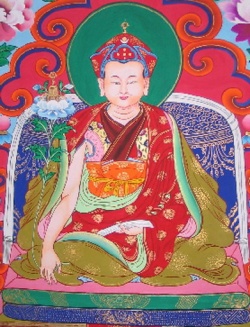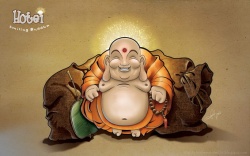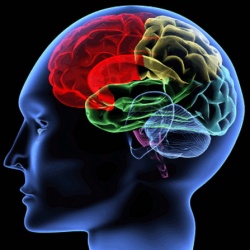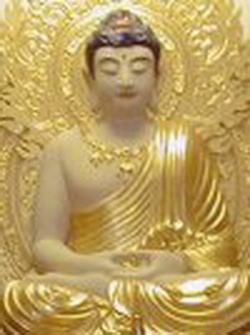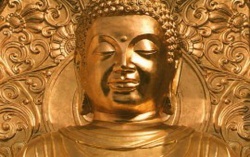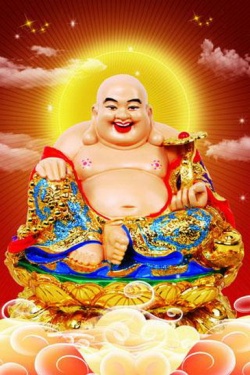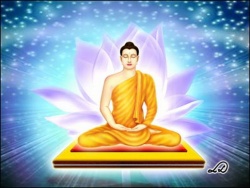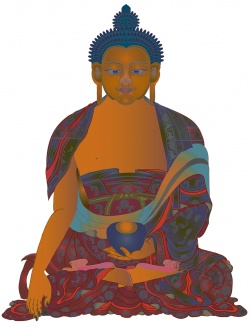Forcing the Truth of the Buddha Event
On Having Right View
Anyone who has even a passing familiarity with Western Buddhism has no doubt at some point heard the accusation that someone is “clinging to views.” The common understanding is that Buddhism is an absolute relativism, a kind of universal tolerance for all positions and opinions, because none are the final truth, and all contain their peculiar kernel of value. As with the tyranny of opinion in Western culture, the underlying “truth” of this suffocating tolerance is a very conservative political refusal to consider the current social formation as being open to shaping by human thought and action (this is no doubt why it is shouted most shrilly by politically right-wing Buddhists, the most rapidly growing group of U.S. Buddhists).
Related to this is the notion that any thought is a “view,” and that “Buddhism teaches” we should eschew all views, so, naturally, we must avoid all thought. We should limit ourselves to deeply feeling and completely accepting emotions, which, it is believed, are “view-free.” Recently, a pro-capitalist Buddhist, particularly comfortable financially and confident in the existence of an ultimate state of bliss in the afterlife, emailed me this piece of advice he found on some x-buddhist blog: Our (Buddhist) practice is best when we have little or no concern for what others do or think — and even or especially what we ourselves think — and pay attention, instead, to how we unfold in our own unique dance with the present moment. I’m not sure who wrote it, but it couldn’t express more clearly the standard Western Buddhist pursuit of the illusion of infantile imaginary plenitude. Buddhist practice is an attempt to stop thinking, ignore all others, and float in a fantasy of sensory comfort. At all costs, never have a “view.”
This would seem to conflict with the requirement of the Eightfold Path that we seek to achieve Right View. But most Buddhists are able to ignore this contradiction, often by simply translating this part of the path as “Right Understanding” instead. Right Understanding, it turns out, is understanding that we should have no views. We should avoid thought, never make a judgment about anything, and simply emote. To assert, for instance, that it is bad to destroy the environment is a “view” and not acceptable to a good Buddhist. Even to attempt to arrive at a correct reading of a passage in a text by Nagarjuna is to “cling to views,” thinking too much and forgetting to simply feel. Nagarjuna himself (and also the Buddha of the Pali canon) were, it seems, rather bad Buddhists. They thought, argued, asserted that there were correct understandings and incorrect ones. For some Western Buddhists this is okay only for a Buddha—every other Buddhist in history, up until America discovered New Age Buddhism in the last half century, has just been a very bad Buddhist, thinking, trying to reduce human suffering, believing their actions in the world, including political action, could accomplish this. Only today do we have “real Buddhism,” free of thought, effort, attempts to help people in this world (they will all achieve bliss in the “substrate consciousness” when they die, after all), and finally understanding that capitalism and the American construction of our emotional reality is the true Buddhism even Buddha failed to really understand.
The term “views,” then, is marshaled to attack any attempt at thought, political action, or even any attempt to truly understand the real cause of suffering. There are many sutras which, quoted in decontextualized snippets, can support this use of Buddhist terminology. And when a passage does not support this anti-intellectual postmodern relativism, the solution is simple: find an alternate translation of the term ditthi/drsti for that particular passage or phrase. The good atman-Buddhist can then shout down any thought with the cry of “views” while assuring us that their own political position, belief about human nature, ideology, is not a “view” but an “understanding.”
For the atman-buddhist, who rejects the concepts of anatman and of conventional truth, there are only two kinds of thing that exist: the eternal and unchanging “substrate consciousness,” and the ephemeral and insignificant “opinion” that can be changed at will to whatever makes us most comfortable. The traditional Buddhist understanding of the reality of conventional reality, the belief that what is produced by human practice is real and has real causal powers, is rejected; any conventional reality is dismissed as a “view,” and something we should not have. In this way, our social formations become off-limits to the atman-buddhist, and they are free to seek personal comfort in their delusions, denouncing any effort to think or act in the world as not “real Buddhism.”
What if we begin by considering what the term “ditthi/drsti” actually means?
Because it has nothing at all to do with our terms “view” or “understanding.” These are very conceptual terms, terms that refer, for us, to cognitions, something changed by thought alone. The term drsti/ditthi has a vastly different meaning, and it is understood as something we must have, something absolutely essential to have and hold onto with all our ability—what we must avoid is the wrong kind of drsti/ditthi.
Dan Lusthaus, in his book Buddhist Phenomenology, explains the meaning of the Buddhist term very succinctly:
It cannot be overstressed that positions (drsti), from a Buddhist point of view, are not simple, neutral abstract collections of propositions, but charged, passionate, interpretations of experience which thoroughly color and flavor—literally—our every thought, sensation and action. They are produced by and produce embodied-conditioning (samskara), and are thus symptoms of our conditioning rather than neutral alternatives from which one can innocently and naively choose. (242)
In other words, the current term that most closely matches the concept intended by drsti/ditthi is: ideology. They are produced by our social formation, by our practices and actions, and they shape even our emotions and perceptions, our every experience of the world. We can’t be without any drsti/ditthi, but that doesn’t mean we should tolerate any and all particular “interpretation of experience.” Some will surely produce more suffering than others. We cannot change these at will, by some kind of “free” choice—but that doesn’t mean we cannot change them at all. They can be changed, but only through real social practice over time; and we can know the causes and effects of our drsti/ditthi /ideology, but only in rigorous thought—not “innocently or naively.” The difficulty is in making the leap from knowledge of the cultural causes and effects of our drsti/ditthi to the actual practice capable of changing our drsti/ditthi. It can be as difficult as closing the gap between knowing I should eat healthier foods and quit smoking, and actually doing it. It can be done, but the work of Buddhist practice is figuring out how, and doing it. And, like so many changes in our lives, it may be best done with help from a group.
The difficulty the sutras so often warn us of, then, is not the problem of having a drsti/ditthi, but of clinging to one. The problem, that is, of reification. We tend to reify or naturalize our existing ideologies, particular those which serve as the core organizing principle for all of our experience of the World. In Lacanian terms, this is the point de capiton, the quilting point, a sort of transcendental signifier the existence of which anchors and gives meaning to all others: God, Freedom, Love, etc.
We tend to reify particular parts of our drsti/ditthi, lock them in place and assume any other changes we made must still include this one belief that guides all our practices in the world. Sometimes that belief is in the immortal soul, sometimes in the universality of a particular culturally constructed emotion such as romantic love. What we must do, in seeking Right drsti/ditthi, then, is avoid reification. We must recognize that we are producing, in practice, an ideology meant to create us, to make us into a kind of subject more able to interact with the world, and less susceptible to suffering. If it doesn’t work, or if the rigorously intellectual component of our Buddhist practice, which analyzes our ideologies and their effects, suggest we need to change, we must remain open to this change.
The difficulty in translating this key term in the Buddhist Eightfold Path is perhaps not surprising, given our ideology of the subject—an ideology which powerfully determines the language we have available to think about these things. We have a tendency to conceive of a core, free, and unconditioned “self” or consciousness which somehow neutrally interacts with ideas and cultures, which can experience or perceive the world “purely” and outside of any ideology. The problem with grasping the importance of the term drsti/ditthi is exactly the same as grasping the meaning of the term ideology: we cannot see that it constructs our (conventional) selves; instead, we assume it is something our (true) self “has.”
The implication of all this is that it is incumbent upon the Faithful Buddhist to have strong views, to cultivate them with energy and care, and to argue for them and argue against all wrong views whenever possible. It is also necessary to engage in perpetual ideological critique, examining our own practices in and construals of the world to determine where they might limit us or cause suffering, or even when they might depend on the unnoticed suffering of others.
So next time someone shouts “clinging to views” at you, ask them to consider what the term drsti/ditthi actually means.
In closing, then, here is my hypertranslation of a Pali sutra that is often quoted in attempts to silence real thought and to prevent the pursuit of Samma-Ditthi.
Paramatthaka Sutta
When we reify our ideology, assuming our beliefs in practices to be natural and not socially produced, believing all other ideologies to be unnatural, then we are bound to be caught in endless and unresolvable debates and dilemmas. Our ideologies shape our every perception, and are reinforced in our practices, and so our every experience seems only to reinforce our certainty, and we fail to understand, or simply cannot even see, whatever conflicts with our ideological construal of the world.
Those who have learned to think dialectically can understand that any ideology becomes bondage if it is reified. Therefore, we should become able to question even our sensory experiences, our emotional responses, our habitual thoughts and ordinary practices of daily life. We should not assume all ideologies are equal, as some will have more harmful consequences than others; but we must never assume that we have the final, perfect ideology.
Once we can consider our own ideology, can think dialectically about it, including in our ideology the knowledge that it is an ideology, then we no longer need to reify, to seek some final ground which guarantees it—we can abandon the cults of biological determinism and neuroscience as easily as the old cults of gods. We can evaluate the ideologies of others without comparing them to some fixed beliefs-in-practices we assume to be “true”; instead, we make our evaluation by determining the causes and effects, the supports and consequences of an ideology. Then, even concerning our bodily experience of the world, what Lacan would call the imaginary register, we become able to accept that it is constructed in our human practices. Whoever does not reify his ideology, that subject becomes free to remake the World.
The enlightened do not cling to any metaphysics of presence, they do not reify their ideologies or assume that they have the final or correct conception even of things in the non-human universe, understanding that any model of mind-independent reality is part of an ideology, made with some intention, serving a function in a human World. The enlightened do not accept any concept as universal and beyond question. They do not reify an ideology, leaving their ideology open to question, but neither do they participate in ideologies without submitting them to critique.
References
Lusthaus, Dan. Buddhist Phenomenology: A Philosophical Investigation of Yogacara Buddhism and the Ch’eng Wei-shih Iun. New York: Routledge, 2002.
In translating the Paramatthaka Sutta, I referred to the translations by Thanissaro Bikkhu (http://www.accesstoinsight.org/tipitaka/kn/snp/snp.4.05.than.html) and John D. Ireland (http://www.accesstoinsight.org/tipitaka/kn/snp/snp.4.05.irel.html), as well as to the Pali Text Society edition of the sutra.
70 Comments
by wtpepper on November 3, 2013 • Permalink
Posted in Uncategorized
Koans and Conventional Truth
Most of my posts so far have focused on the truth of anatman. There is an inherent negative, critical, or deconstructive emphasis in this concept, attempting as it does to demonstrate the non-existence of something we usually assume to exist.
For this post, I want to shift the focus to the other truth, or perhaps the other aspect of the same truth, to which I want remain faithful on this blog: conventional truth. I want to raise the question of how to force this truth into appearance; more specifically, the question of whether this can also be done in a negative or critical manner, or whether it is better done in a positive or constructive manner. That is, in making an understanding of conventional truth part of our World, is it enough to critique those practices that reify the conventional, presenting it as a timeless truth? Would it be better to instead produce a new conventional reality that can oppose the existing norm? Or, is it perhaps unavoidable that we must do both, that we cannot know how to produce a new conventional reality in real practices and discourses until we have first done the work of critique?
To address this question less abstractly, I’m going to use a specific example of reification of the conventional, from Barry Magid’s recent book Nothing Is Hidden: The Psychology of Zen Koans. I have no intention of reviewing this book here. I simply want to consider whether this kind of x-buddhist “koan practice” can serve as a negative example; can we use Magid’s presentation of koans to de-reify the assumptions of our culture? And if so, does it produce a beginning point from which to construct new conventional realities?
I have been alternating, so far, between the terms “conventional truth” and “conventions” and “conventional realities”; so before moving on to discussing one of the koan presentations in Magid’s book, I want to briefly bring attention to the danger of reification inherent in the very concept of conventional truth itself—a danger that can be avoided, I think, but only if we remain alert to it.
In the introduction to the book Moonshadows, Newland and Tillemans explain the difficulty of translating both parts of the term samvrti-satya. The first part, usually rendered as “conventional,” does not quite mean what we ordinarily mean by the English word; when we think of something as “conventional,” it has as sense of something optional, an irrelevant or unimportant (usually, by connotation, outmoded) practice or belief. But the original term has a meaning not covered by any one English term. It seems to suggest things that are actually real, but exist only as a result of some human practice, so that a chair would be “samvrti” because it would not exist in nature, but is nonetheless very real, not a mere “old-fashioned belief” that can be ignored but something with real practical use. Samvrti also carries the sense of “concealed” or “covered over,” implying that the possibility of reification is part of the very concept—the possibility that we can mistake conventions for natural occurrences. There is also the possibility that it is meant to indicate a sort of “covering” for the natural world, a “layer” of practices and intentional objects enabling us to interact with the world. We need to keep this peculiar use of the term “conventional” in mind, to avoid the danger of falling into an assumption that Newland and Tillemans point out has occurred in Buddhist thought for thousands of years: “Isn’t ‘conventional truth’ just a euphemism for ‘false’? Isn’t the ultimate the only actual truth?” (15). They point out the tendency to assume that conventional truth is somehow less important; my suggestion here is that because it can be changed it is in some ways much more important for us to investigate.
The second part of the term is just as problematic. As Newland and Tillemans put it, “because satya means ‘truth’ but also can mean ‘real’ and ‘what is existent,’ translational problems are unavoidable”(4). We need to be wary of the erroneous assumption that there is always a clear and correct term with which to translate any language into any other. The difficulty here could lead to debates over whether satya “really” means truth or “really” means real; the important thing to recall is that it is a term in a symbolic system so radically different from ours that no single sign in our symbolic system exactly serves the same purpose as this sign does in its original symbolic system. The Sanskrit term indicates a construal of the world which is difficult for us to grasp; from our post-Kantian system of thought, with its focus on epistemology and consciousness, it is difficult to imaging a World in which there is no distinction between the true and the real. Emphasizing “truth” over “reality” in the translation tends to make conventional seem like something we should ignore, or somehow get outside of, which is the approach most Western x-buddhisms take. Emphasizing the “real” in the concept can help us remember that human social practices are not optional, and have real causal powers, and must be taken seriously.
Keeping these qualifications in mind, recalling that “conventional truth” has a very specific meaning not really indicated by the ordinary use of the English terms, can we begin to examine conventional truth and take it seriously? Because the important thing is never to assume that only the ultimate reality is “really real.” The conventional reality is just as real, and is even more important than the “ultimate” because it is the only one we can change. The laws of physics are something we should learn because we can make use of them; the structure of the human subject is something we should learn because it is something we may want to change.
Now, to the example.
Magid sets out to combine psychoanalysis with Buddhist thought, and to use Zen koans in a very different manner from their traditional use, one that Magid hopes will have therapeutic benefits. He begins, of course, by rejecting the core, founding assumptions of both psychoanalysis and Buddhism, and so creates a kind of new-age pop-psychology which can only serve to completely reify our existing ideology of the subject.
Magid’s “psychoanalytic organizing theory” is that of Kohut’s “self-psychology,” which explicitly set out to reject the Freudian concept of the dynamic unconscious and to produce an ideology of the subject fit for post-World-War-II America. In the words of Phillips Cushman: “To be human, Kohut seemed to be saying, is to be a psychological consumer. The self he described is an empty self that longs for the proper commodity, the empathic selfobject, in order to fill up the emptiness and liberate the enchanted interior”(271). Kohut, in short, was terrified of the possibility that psychoanalytic theory could see the self as a social construct, its suffering as social symptoms not individual problems, and so set out to reify the consuming atomistic self, existing in “relation to” other atomistic selves, which could then be healed by giving it the right kind of emotions to “consume.” Magid cannot even conceive of the Freudian understanding of the dynamic unconscious, as the lack in the symbolic system, as the aporia or failure of our construal of the world; in typical Anglo-American fashion he mistakenly assumes the unconscious must be full: “Freud … postulated [the unconscious as] filled with thoughts, fantasies, and wishes so upsetting to our ordinary conscious mind that they must be repressed”(11). If he had ever read even a little Freud, he might not accept this Psych-101 textbook definition of the unconscious—but to read any Freud at all would make it nearly impossible to accept Kohut’s self-theory as anything but the most disturbing kind of ideological reification.
When he comes to Buddhism, Magid’s understanding is of the most thoroughly “atman-buddhist” kind. He repeatedly refers to our “own intrinsic wholeness and perfection”(6), and creates a Buddhism which begins with Shakyamuni’s “experience of wholeness and perfection.” What we are missing, he says, is emotion—that one part of this perfect and whole self that we have split off and denied. This is, he says, repeated in the tradition of Zen koan practice, which “simply fail[s] to address emotion”(7); but this failure is the result of the cultures in which Buddhism has been practiced: “inequalities have been culturally grafted onto Buddhism over many centuries in Asia and are only now being questioned as it is transplanted in America”(9). All those Buddhists in Asia, for thousands of year, have been hindered by “culture,” but now, in the ideology-free land of America, we can finally restore true Buddhism, which, it turns out, was always meant to produce a properly-interpellated capitalist subject.
The koans, we discover, were really about emotions all along. They have just been misused by overly-intellectual male Zen Buddhists who were repressing their emotions. Restoring the emotional focus of a koan, then, can help us to heal the traumatic split that causes our originally whole and perfect atman to suffer.
To sees how this works, let’s consider one particular example. I choose this not really at random, but because it is a koan I particularly like, one I think is particularly useful, and so Magid’s efforts to press it into the service of the production of capitalist subjects strikes me as exceptionally obvious and hollow.
In Chapter 9, “Traumatic Dissociation,” Magid considers the koan of “The Soul of Ch’ien.” Briefly, the story involves a traditional tale of a young woman who is forbidden to marry the man she loves. The young man leaves the village to go start a new life elsewhere, and discovers that Ch’ien has followed him, against her father’s orders. The two marry and start a life togehter and raise a family. After many years, Ch’ien wants to return to visit her family, and on returning the husband discovers that her parents believe she has been lying in bed sick for all these years. When Ch’ien walks into the room in which her “body” lies in bed, the body gets up, and the two come together as one being. The traditional koan simply asks: which one was the “real” Ch’ien?
Magid takes this story as an opportunity to rehearse the recent obsession with trauma, seeing Ch’ien’s as the victim of a traumatic experience, and her desire for romantic love as a natural requirement of her natural soul. The story is used to reify our current social construction of emotion, and to assure us that “healing” is a matter of consuming the right kinds of “emotionobjects” in the right way. We are all “split” by trauma, because we have emotions which we do not know we have—they somehow exist, more real than our thoughts, despite our never “feeling” them, and all we need to do is to accept and feel those emotions to be happy. Of course, Magid gives a nod to the typical x-buddhist understanding of “non-self” when he suggests that “who I am is always subtly changing and being changed”(92), but it is clear enough that these changes are minor, insignificant to the core “true self” that moves from one experience to another, the self that includes those “dissociated” emotions that are eternal, undying, and exist powerfully for all time whether we feel them fully or not.
Magid discusses the difference between a “horizontal” and a “vertical” model of the self, one changing with each new situation the other masking a real true self under a social veneer, and simply suggests that we should choose whichever model best helps us to accept whatever social practice we are currently engaged in—because, it is implied, we are not constructed by our social practices, but take part in them, and we cannot change our social formations, but only heal our true selves. Ch’ien’s real self is her emotional self, her “love,” which is not socially created but part of who she “really is” and must be accepted in order for her to be “whole.” Her father traumatizes her by denying her emotions, causing her to become split. The solution, for Magid, is a new kind of split self, able to do whatever is asked of it in any situation, because it can keep its “true self” for other situation—we can, he suggests, both be obedient and love, each at the right time. Each new experience, then, doesn’t really change “who I am,” as he suggested earlier, because the true self has just learned to compartmentalize. Nothing is changed in our selves, we just adapt to the demands of the world by using only those parts of the true self that are suited to the moment, but careful always to give the other parts their turn at the controls.
I assume I don’t need to go through all the logical errors and rhetorical sleight-of hand Magid uses to produce his ideology of a core self trapped in an inadequate world. It is really no different from Mark Epstein’s discussion of trauma in The Trauma of Everyday Life. Surely Magid must see these himself; I assume he does, and just accepts the existence of an eternal soul. What I’m really interested in is whether there is any value to using this kind of x-buddhist material as part of a critical practice. Does critiquing this kind of delusion, pointing out the conceptual error, the assumptions, the reification of current conventional reality, help to produce new options for us?
We could simply offer a more useful understanding of this particular koan. An understanding that accepts anatman and dependent origination would give a different response than Magid’s to this story. Where is the “true” Ch’ien? The subject “Ch’ien” is produced in the contradiction that has emerged in the social formation, a contradiction between marriage based on companionship and marriage as a social contract. The contradiction produces the idea of “true love,” the empty concept that transcends the conflict between socially produced desires and socially produced obligations. The story of Ch’ien’s soul is of enormous interest because it make clear exactly how her “love” for her husband derives all its strength from the sublation of an older social formation that is being transformed; her happiness with her husband, and his with her, depend on their belief that they are doing what has been forbidden them, that they are fighting against the patriarchal demand. The real “Ch’ien”, then, is in the social contradiction that makes real social change, and so real agency, possible; more specifically, in the practical actions that result from that contradiction (the young man leaving his village to make a new life). The subject is in the practice that the contradiction forces into existence.
We could give this answer to the koan, one demonstrating a real grasp of core Buddhist concepts that Magid rejects, but the result is that we are left with no reification of love, no core subject to be restored to wholeness. We are left only with a demand that we seek out the contradictions that give power and energy to our own emotional cathexis, our practices, our hexis in the Aristotelian sense, and produce new practices or new a hexis with that energy. Instead of emotional comfort, we are given an opportunity to make effort in the world.
So, Faithful Buddhists, what are your thoughts on the matter? Is it a useful practice to deconstruct such texts as Magids? Or are they too easy, too obvious, likely to produce their interpellative delusions only for those so naïve the very term “deconstruction” would mean nothing to them at all? Do they, in any sense, reveal some of our deeply held, often unexamined, assumptions and errors? Or are we better off seeking these elsewhere, in our favorite poems, or movies, or sporting events?
Or are we perhaps better off avoiding the negative critique altogether, and attempting some positive practice? Perhaps engage in some new kind of collective creative endeavor instead of endlessly deconstructing those that exist? What might this creative activity look like? Organized protests? Community theatre? Independent film making collective? Journal for radical literature? Where can we produce ideology, instead of only critiquing it?
My own sense at the moment is that perhaps we need to do both, that perhaps we cannot consciously produce ideology except out of a critical transformation of our existing ideology. But I am by no means certain of this.
Any suggestions?
Works Cited
The Cowherds. Moonshadows: Conventional Truth in Buddhist Philosophy. Oxford: Oxford University Press. 2011.
Note: To anyone who hasn’t read this book, I would say that I think it is one of the best collections of essays on Buddhist thought I’ve ever read, and reading even just the first couple of essays here will teach you more about Buddhism than all the popular or introductory books on Buddhism published in the last three decades.
Cushman, Philip. Constructing the Self, Constructing America: A Cultural History of Psychotherapy. Cambridge, MA: Perseus Publishing. 1995.
Magid, Barry. Nothing is Hidden: The Psychology of Zen Koans. Boston: Wisdom Publications. 2013.
25 Comments
by wtpepper on October 21, 2013 • Permalink
Posted in Uncategorized
The Practice of Thought and the Subtle Atman
Thinking As Practice
Since the publication of the book Cruel Theory | Sublime Practice, I have gotten mixed reactions from the handful of people who took the time to read it. The most consistent complaint about my particular contribution to the book, however, has been that I only critique the beliefs of others, and offer nothing positive as an alternative.
Along the same lines, the most consistent response to my several critiques of x-buddhists on the Speculative Non-buddhism blog is that I am obsessed with hunting out the subtle atman, so that I find this error everywhere. Instead of addressing the positive ideas being offered, I obsessively hunt out errors that are not part of the author’s intent.
I see these as, in effect, the same critique.
Those who want something “positive” instead of “just critique” are asking for a comforting ideology, a place to rest and stop thinking. They want the aporia or error to be sufficiently obscured, out of our awareness, to that we can live more easily in the world, with less mental effort. This is sort of like the recent return to “aesthetics” and formalism in Literary scholarship: it is time to stop deconstructing works of literature, to give up on tracing the ideological practices producing the particular perception of “beauty,” and to just return to feeling strongly the emotional and artistic power of a work. The goal is to stop the endless effort, and just feel more, and feel better.
Against this I would simply say that this endless effort simply is the practice. It is not a mere preliminary to satisfyingly sitting in states of euphoria, or fully enjoying a cup of tea, or feeling more deeply loved, etc. Thinking is an activity, and is the practice of the Faithful Buddhist.
I would ask that we consider the series of sutras in the “The Book of the Aggregates,” book 3 of the Samyutta Nikaya. What does this teach us to do? Exactly to contemplate, or consider, or understand, that the five skandhas each fail to function as an essential or core “self.” Form, feeling, perception, mental formations, and consciousness each is dependently arisen, and there is nowhere an essence or “true self” that is not completely the effect of conditions.
Often, this is taken as proof of a world-transcendent soul, so that this investigation is understood to be merely the first step, before the “positive” practice of achieving comfort and happiness can begin. But what is taking place here can be seen as a complete deconstruction of the hegemonic ideological formations of the time. Too many Western Buddhists get caught up in trying to understand what is meant by these five concepts, the skandhas. But we would be better served by attending to those concepts which we use, today, to create the illusion of a core, true self—often even while we deny it exists. This kind of investigation is not a preliminary, not a way to come to see were the self “really” is. It is the whole practice, which consists in always seeking the tendency to reification, to an aesthetic mystification of the aporia of our concepts. These aporia always function to screen the same thing: they obscure the social production of our concepts, to enable them to become naturalized, reified, and more comforting for those who benefit from the existing social formation.
So my answer is that yes, I am obsessed with finding the subtle atman, and I find it everywhere—because finding it is the practice, and it is everywhere. Or almost everywhere. In any comforting practice that reassures us that the World cannot be changed, but we can be more at home in it, there is certain to be a subtle atman.
And no, I don’t offer anything “positive” in the sense of a practice that increases our equanimity or peace or contentment and escapes thought and effort and engagement. The goal must be to learn to actually take pleasure in thought and effort and engagement. When it is so horribly unpleasant to think, so terrifying that it is seen as the ultimate evil today, then we should take that as a clear indication that there is something horribly wrong with our World, and we need to change it.
Thinking is a practice, engaged in socially, in the World. If you think it is “mere thought” or “theorizing” or “being overly intellectual” or “a thicket of views,” then you have just never learned to actually think. Thoughts are what we are made of, they are social actions, and should not be scary at all.
So, instead of a hypertranslation of the Udana Sutta, I’m going to offer a modern equivalent here. A brief investigation of two examples of the subtle atman I have recently encountered, exploring how they work to reify a particular ideology, and so perpetuate suffering.
The Addict’s Free Will
There is a small movement in the disciplines of psychology and psychiatry to reconceive addiction as a “syndrome.” Or, at least, the participants in this movement seem to believe they are “reconceiving” addiction. There actually isn’t much new in their approach: addiction has always been understood to be exactly what the term syndrome means, something with no known, or perhaps no possible, explanation within our existing construal of reality. Addiction defies explanation, and that is what defines it as addiction.
Of course we are promised some future explanation, in the form of genetics or neuroscience, but none is available at the moment, so we must simply treat the symptoms, as with most syndromes.
The biological emphasis in this approach to addiction, like all our modern neuroscientific or neurocognitive approaches, rests on the assumption of an ineffable “consciousness” trapped in a body which somehow doesn’t serve it very well. I say assumption because this is never made explicit, and in fact is almost always explicitly denied; the subtle atman in neuroscience is usually screened by a rhetorical sleight-of-hand, most of the time screened even from the neuroscientists themselves, who fail to notice the implied transcendent “self” that is observing, believing, intending, etc., whatever the brain does. Just as Hume discovered, in his attempt to develop empiricism into a complete theory of the mind, any form of reductionism will always either produce contradictions or require the belief in a transcendent soul or mind.
But for the moment, I want to set aside the neuro-everything debate, and focus on an essay in the recent APA Addiction Syndrome Handbook which makes the assumption of an atman most explicit: “Self-Control and Addiction,” by Jessica L. Alquist and Roy F. Baumeister. This is the most explicit statement of the new approach, and makes it most clear that this is really just the same old moralistic approach, with all its assumptions of a Cartesian self having free will and so moral responsibility for the actions of the completely determined body. It may seem that I am just picking on the worst chapter in this very long, 2-volume work. I would say it is, in fact, the best, because it is the only one that fails to completely ignore the implications of the “Addiction Syndrome” project.
Alquist and Baumeister explain addiction as the result of two related problems: 1) the addict fails at “self-regulation” and 2) he excuses and perpetuates this failure by denying the existence of “free will.” The key problem with self-regulation, for the addict, seems to be in what I would call an ideological contradiction. Alquist and Baumeister use the term “standards” to indicate the intentions of the “individual” and the practices he undertakes to achieve those intentions. When two standards are “conflicting,” or when one’s “particular behavior” conflicts with a standard, then the result can be addictive syndrome behavior.
Now, it is clear enough that the separation of the “individual” from his brain and behaviors is a kind of atman in itself. But what is more interesting to me, in terms of the treatment of addiction, is the concern that it is always a sign of mental disorder to become aware of ideological contradictions. When the “goals…align, quitting is more likely to be successful” (167). The point is never to determine the correct goal, or to examine the source of the conflict, but to remove it from awareness. All capitalist ideologies will have some form of contradiction, whether between two opposing beliefs (e.g., cooperation and competition) or between beliefs and practices (e.g., belief in “freedom” and the necessity to sell one’s labor for wages). If these contradictions become evident, we become bad subjects, in need of intervention and re-interpellation by psychological professionals.
The alternative might be to investigate these contradictions, and to initiate a new practice which works to remove their cause in the world. The addiction would be understood as the form of subjectivity a particular social production creates—the addict doesn’t have a symptom of his own inadequate “self-control,” but is a symptom of an inherently contradictory social system. Producing new practices, and so altering the social formation in which the subject is produced, could avoid the self-destructive solution the addict has “chosen,” but it has a cost: it also rejects the assumptions of an autonomous self, separate from and unconstructed by the social formation, and, as a result, would encourage social activism and resistance to capitalism. Not the outcome psychologists are paid to achieve.
In discussing “free will,” Alquist and Baumeister attempt to dodge the old philosophical debate over whether it actually exists by simply focusing on whether the addict believes she has it. People who “believe in free will” are less aggressive, more cooperative, less likely to cheat; they perceive their life as “meaningful,” are more successful at work, and like their jobs (171)—in other words, they are “good subjects.” Their assertion is quite explicit:
[R]esearch on free will on free will has suggested that people’s behavior is influenced by the amount of freedom that they believe they have. Such evidence argues against the idea that addiction is outside of an individual’s control. (171)
I would suggest that the conclusion to be drawn is exactly the opposite. Those who are properly interpellated, who have good and satisfying jobs, who are oblivious to the contradictions in their social formation, are those who are least likely to be “bad subjects,” and so to be addicts. They are the most completely mistaken about the real nature of the world, and so most completely without any true agency—believing, mistakenly, that doing exactly what is expected of them is “free will.”
What this purported theory of addiction amounts to is a simple tautology. Those who are properly interpellated into the hegemonic ideology tend to do what the hegemonic ideology expects of them—because ideology just is what we actually do, it is the practices we engage in. When we engage in the practice of thought in ways that call attention to the contradictions of our ideology, we become bad subjects. Also, when our actual experiences just cannot align with our beliefs, we become bad subjects, not feeling at home in the world, not feeling our lives to be “meaningful” and satisfactory, and so acting in undesirable ways.
The solution offered by the proponents of the “Addiction Syndrome” is nothing new—it is a solution as old as capitalism: an aesthetics of the beautiful. If we can align our concrete experiences with our beliefs about the world, we will be healed. Aligning the concrete particular to the abstract universal has always been the goal of the aesthetics of the beautiful, and it has always been offered, since the very beginning of the concept “aesthetic,” as a way to cure what ails us, and to make the wheels of capitalism run smoothly. If the alignment requires that the bad subject stop thinking so much, and actually become unaware of the contradictions of the social formation, then deluding her in this way becomes the job of the psychologist.
The error of assuming the existence of an atman, then, serves both as the cause of our inability to grasp addiction, and the solution to the inexplicable “syndrome.”
When Bad Subjects Can’t Be Good: the example of David Foster Wallace
Why is this important? If people believe they are happy, and have meaningful lives, wouldn’t that be good enough? Well, there are two reasons why it is not. The big reason is that in a capitalist system some people experience happy and “meaningful” lives, but only at the expense of billions of oppressed human beings living in poverty. The other reason is that deluding people in this way so often fails, and so many addicts and other bad subjects are left to suffer and die because they refuse to exercise their “free will.” It only works if you want it bad enough, they are told. Like telling a suicidal patient to come back when she wants to live, then you can treat her.
I want to offer an example of one well-known addict, who also suffered from severe depression, and ultimately committed suicide. He remained caught in a contradiction he could not, because of his particular subject position, avoid coming up against, but to which he could not find a solution. The solution offered him by the best professionals was to stop thinking so much, and to just feel authentically. What was suggested was, in short, that he continue engaging in exactly the practice that made the contradiction so evident and painful to him, and stop engaging in the practice that could, potentially, have enabled him to work against the social structure producing this contradiction.
I don’t want to produce another Romantic tale of a suffering artistic genius who could not live in this corrupt world. Rather, I want to suggest a tale of a subject who served as a symptom of an ideological contradiction, and whose Literary output and life story now help to maintain the social formation that produces such suffering subjects, which suffering subjects help, in turn, to keep the rest comfortably deluded and happy. They are, in short, not geniuses too good for the world, but deluded sacrificial victims to our hegemonic delusions and ignorance.
David Foster Wallace was lauded as a genius, and graduated from Amherst College with honors in both English and Philosophy (Jay Garfield worked with him on his Philosophy thesis; his English thesis became the novel The Broom of the System). He published a novel, got an MFA in creative writing, published a collection of short fiction, and then began the PhD program in Philosophy at Harvard. He didn’t make it through his first semester. Discovering he was poorly prepared for graduate school, that he could not understand the reading or follow class discussion, he became depressed, drank and drugged heavily, and went into rehab, where he was told that to get sober he would have to quit graduate school. His biographer, of course, portrays this as the true genius impatient with the “sheltered” and overly intellectual atmosphere of academia, but it seems clear enough that Wallace was stunned to learn he was not as smart as he thought, and could not bluff his way through a PhD program at Harvard the way he could through an undergrad thesis.
The cure was typical: get stupid. That is, quite literally, what addicts are always told. Stop thinking, and just feel, crush your mind, kill it, in menial manual labor, and you will become able to “feel” without thinking, and then you are cured. Wallace attempted to buy this, it seems, but it didn’t work forever.
He had already come up against a fundamental contradiction of the construction of the self in the Romantic form of capitalist ideology. When trying to write, he struggled with the impossibility of both writing what sells, giving the audience what it wants, and still being “authentic,” and writing “serious” fiction. He tried, for a while, to maintain the stance of the Romantic artist. In a letter to Jonathan Franzen, quoted in D. T. Max’s biography of Wallace, he asserts that he is indifferent to the critical reception of his long story “Westward the Course of Empire Takes Its Way,” because, he says, “it is exactly what I wanted it to be…also truly about everything I either had to write about or die in ‘87” (98). The problem is, he really does need the story to be liked by somebody—he must have an approving audience to be a writer at all. He is troubled by the terrible thought that he may need to actually work to make a living in addition to writing, because as the “artistic genius” he must do nothing so sordidly inauthentic as work for pay. He must remain the pure and beautiful soul. The dilemma, then, is an old one: can he write what is truly and authentically an expression of his unique and autonomous self, indifferent to audience, and yet be universally applauded and paid well for it. Is the depth of his soul so beautiful that expressing it will enrapture the masses? His last completed novel, Infinite Jest, turns on the creation of the perfect work of art, a movie so irresistibly enjoyable that to watch it is to die—and the movie maker kills himself after completing it.
Here is how Terry Pinkard, in his commentary on Hegel’s Phenomenology of Spirit, describes the “deep problem with such a form of self understanding”:
[E]ach romantic agent understands himself as acting not in terms of anything constituted by “external” social institutions but only in terms of his own deepest self. In the terms of the romantic individual’s self-understanding, if he is to act out of what are really his own motivations—it his self is to identify with his activities, if he is not to be alienated—then he must act from convictions that come from his “self,” not from convictions that have been “imposed” on him by “society.” The romantics are thus faced with the problem of how to unite the impersonal point of view of the community (the “universal”) with their own deeply subjective point of view (the “individual”). (212)
It is also, partly, accomplished with the concepts of “genius” and the “beautiful soul,” longing to find other beautiful souls to hear, and to recognize, his genius in his purely subjective expression. To resolve this impasse, on Hegel’s account, the romantic “selves” must come to realize that “they are indeed held together by a set of shared beliefs…that the significance of what one does is a matter of its recognition by members of the community”(219). In effect, the solution to being a bad subject, suffering unto death, is to recognize that one’s “deepest self” is socially constructed all along, and if it is poorly constructed, the fault lies not “deep within,” but in the social formation, which we can change, but only once we, collectively, as a community, realize how it constructs us.
Wallace never got to this point. He continued to write postmodern fiction, in the sense Jameson defined this term three decades ago: works that precisely prevent us from seeing the structure beneath the phenomena that we are, and keep us entranced by pure surface, convinced there is no alternative to the way things are, the only solution is a kind of ironic nihilism coupled with mindless hedonism.
I will end with a response to the famous commencement speech Wallace gave at Kenyon College in 2005, which has been widely circulated on the internet, on YouTube, and even published as a kind of book of daily affirmations, with a single sentence on each page. In this talk, Wallace begins with what might seem promising to someone seeking to promote the full understanding of anatman. He opens with the old anecdote about two fish swimming along, who encounter a wise old fish that says to them “Hey boys, how’s the water?” They swim on, and then one turns to the other and says “What the heck is ‘water’?” Wallace suggests that noticing the water, becoming aware of what we ordinarily do not, can help us to “do the work of somehow altering or getting free of [our] natural, hard-wired default setting which is to be deeply and literally self-centered and to see and interpret everything through this lens of self” (3). But what he means by this has nothing to do with the idea of anatman. What he means is that we must completely conceive of our “self” as separate from the water, so very separate that we can become aware of the water as a thing, in what sounds very much like the kind of “mindfulness practice” widely taught at rehabs like the one Wallis went to: “simple awareness, awareness of what is so real and essential, so hidden in plain sight” (9). We can perceive the water “as it really is” only once we have convinced ourselves that our true self is completely separate from it. He has become convinced that he had a “tendency to over-intellectualize stuff”(4), and that he finally learned to stop thinking so much and just exercise his free and autonomous “control over how and what [he] think[s]…to choose what [he] pay[s] attention to”(4). He offers a rather grim metaphor, mentioning that adults tend to commit suicide by shooting themselves in the head, to kill this “grim master” of thought. Instead of rational thought, which is a terrible dictator, forcing us to base our beliefs on mere evidence and argument, we must see that “how we construct meaning” is “actually a matter of personal, intentional choice”(2). Following our intuitions, abandoning thought, living purely in “awareness” of the present moment, convinced that we are pristinely separate from anything social or external at all, if we only choose not to let thoughts corrupt and influence us—that, Wallace says, will make us “well adjusted.” Indeed it will. Three years later he hung himself.
And his writing continues to serve today exactly the subject position he was constructed to serve in his bodily existence. It is the postmodern work of art that entertains us, and prevents us from looking for social causes. It keeps us telling stories of genius, beautiful souls, and authentic, true selves.
If we want to live as agents in the world, without suffering, and able to act, we need to abandon the delusion of the atman, and root it out in every appearance. That is the practice, and it needs to be done collectively, because, as Hegel reminds us, what we do is always social, and our practices can free us only if we choose them consciously and collectively.
Maybe if Wallace had continued to think, he could have abandoned the dream of wealth, the terror of work, the infantile wish for imaginary plenitude that motivates so many writers and artists (if I can just make a fortune only for expressing my deep self). Perhaps he could have turned to writing that was not postmodern, in the strict sense of the term, but worked to demonstrate the ideological conventions that shape us right to the core—like the myth of exchange value, structuring even how we perceive art, making us believe there will be a novel of infinite and timeless beauty and power to produce pleasure passively, with no effort on our part, like the video in Infinite Jest. We can sit back passively and be entertained to death. Perhaps if we succeed, those laboring in destitution will at least be free to pursue other practices of their own, collective, choosing.
So, after this long post, I will make a simple request of anyone who reads this: offer us an example of the persistent assumption of the atman. What dangerous effects does it have? What alternative practices does it obscure?
Works Cited
Jessica L. Alquist and Roy F. Baumeister, “Self-Control and the Addict.” In APA Addiction Syndrome Handbook, Volume I, pp 165-174. American Psychological Association, 2012
D. T. Max, Every Love Story is a Ghost Story: A Life of David Foster Wallace. Viking, 2012.
Terry Pinkard, Hegel’s Phenomenology: The Sociality of Reason. Cambridge University Press, 1996.
David Foster Wallace, Transcription of the 2005 Kenyon Commencement Address -May 21, 2005. http://web.ics.purdue.edu/~drkelly/DFWKenyonAddress2005.pdf
15 Comments
by wtpepper on October 4, 2013 • Permalink
Posted in Uncategorized
Anatman and Collective Agency
How do we get from the concept of anatman to the possibility of agency? If we accept radical non-duality, and absolute dependent origination, the only source of happiness is acting in the world—there is no atman to escape this samsaric world, and nirvana is simply liberated action within it. What does agency look like, if there is no self to will or direct an action? My contention here is that this is only a problem if we have a mistaken idea of what constitutes agency.
Even once we begin to try to understand the concept of anatman fully, there is a powerful tendency to remain stuck in an atomistic understanding of the conventional self. We believe we can become enlightened on our own, indifferent to the social formation in which we live, or even in opposition to it.
This error will always requires the quiet assumption of some kind of transcendent essence, the “back-door” atman which is assumed in the grammar of our statements about mindfulness or awareness, but which most x-buddhists will dismiss as unimportant (as just a feature of language) or will simply refuse to acknowledge at all. It is not unimportant; instead, it is the worst kind of error, perhaps even worse than not attempting to understand anatman in the first place.
Because of this error, most x-buddhists will try to practice some kind of “mindfulness,” an attempt to be fully aware of the pure and un-constructed perception of the world; they will refuse to acknowledge the social practice (e.g., mindfulness meditation) which produces this supposedly “pure” perception, just as they will refuse to acknowledge the error of the assumed transcendent (unconstructed) “self” which does this “pure” perceiving. What happens, then, is that this practice of mindfulness meditation works to reify the socially produced structure of our perceptions, helping us not to be more aware, but to be less aware of those potential failures of the structure of our perceptions, of the parts of reality that our ideological construal of the world cannot include. Phenomenology in its Hegelian form is perhaps a more familiarly Western way of understanding this social construction of what appear to be “pure” perceptions. As Robert Pippin explains, “our discriminated attentiveness never occurs episodically, but as a part of a totality or whole within which any such discrimination must fit, and so any such attentiveness is subject to a certain sort of strain when it threatens not to fit. That totality is a norm, not a law of thought” (Self-Consciousness, 24). The point here is that our social practices, including but not limited to language, create a kind of organizing totality which structures what can count as a correct perception; however, this is a norm, not a law. That is, this is socially produced and maintained, not inevitable, and in fact it very often, perhaps always, threatens to fail. Mindfulness practices then attempt to reify these norms, and shore up our ideologies, hiding from us the fact that they are socially produced ideologies.
This is connected to the tendency of Western Buddhism to insist on remaining apolitical, and to limit the definition of “engaged” Buddhism to charitable work within the existing social formation. We have the illusion that we can become aware of those thoughts and desires which are socially constructed, and so control or remove them, without needing to change the social formation in which we live. So the x-buddhist would say to give to the poor, but would be unable to examine the social formations in which such giving would occur, the very same social formations that make these charitable acts necessary to begin with. They become unable to understand that giving charitably simply reproduces the assumption that money and exchange value and private property are universal and natural occurrences. It remains inconceivable to them that giving charity strengthens the social formation, and they cannot consider the possibility that we might, instead, produce a social formation in which food, shelter, and medical care are a right, not something to be given out of charity, not something the poor must somehow “deserve” with their humility and good behavior and gratitude.
The concept of anatman would require us to understand that the “self” is completely an effect of social structures. Nobody ever succeeds in becoming wealthy on their own, because the very idea of wealth, of money with exchange value, requires an elaborate social structure and the participation of every person in our World. To paraphrase Pippin’s account of Hegel once again: the most important point that Hegel makes is that it is not individuals that support and sustain social structures, but social structures that support and sustain individuals (Practical Philosophy, 4-5). We are produced as conscious beings in our social practices, and we cannot change who we are, and cannot be fully liberated, until we become able to choose and change our social practices.
We can change these practices only collectively. Just as any language requires multiple individuals, any social practice requires a collective to participate in it. We can only produce better social practices collectively; they can never be prescribed in advance by some individual who plans them out, because the thinking involved in such planning would necessarily occur in the current socially form of reasoning, and so would of necessity be limited. As a result, any such collective practice would always be a “work in progress,” not a dogma. Think, for instance, of the stories of the earliest Buddhist sangha and the Buddha’s gradual changing of rules (such as the acceptance of women into the community). Such changes would not be a sign that the Buddha’s original “awakening” was incomplete; rather, the ability to make such changes would be a sign that the sangha as social practice was enlightened.
Terry Pinkard explains that for Hegel the “spirit as social practice” comes to its ultimate development when our “religion” as “the institutional and communal practice of…reflection and affirmation … seculariz[es] itself in the modern world, although without thereby abandoning its sense of itself as religious”(220). There must be a social practice in which we collectively affirm and reproduce what we decide, in the social practice of thought, are the important commitments of our human lives. Such a practice should be the goal of any serious Buddhist, as it was the goal of the earliest Buddhist sangha. Any x-buddhist who asserts that an individual can “freely choose” to suffer or be enlightened regardless of the social circumstances is just somebody who has not yet even begun to understand Buddhist thought, and shouldn’t be making any pronouncements about what awakening or Buddhist practice is, never mind trying to teach. Similarly, anybody who claims that all that marxist analysis of social and economic systems is irrelevant has not yet begun to understand Buddhism. Such analysis is crucially important, perhaps the most important thing, because it is in these social practices that the mind is produced, and it is dependent on these social practices that it will either suffer or flourish.
To try to explore how this issue was understood in early Buddhist thought, I made an attempt at a hypertranslation of the Cetana Sutra from the Samyutta Nikaya (SN 12.38). This is certainly a more tendentious hypertranslation than the previous one—it may be hard to recognize it without looking at a more conventional translation and making a comparison.
Cetana is usually translated as “volition” or “intention” or “will,” but I translate it here as “agency.” That term seems to me to be more in line with the concept at stake in this series of sutras. “Will” or “volition” would assume the existence of an undetermined “self,” separate from this world—this has always been the assumption plaguing Western thought, making it difficult to grasp what true agency might be, to think that agency might be the ability to act because of social structures, not in spite of or in indifference to them. The assumption that what is at stake here is “volition” leads to the inevitable implication that the goal is to be rid of all consciousness, to be free of thought completely; this, of course, leads us once again into the assumption of some kind of thought-free atman, some “substrate consciousness” or essential self that is not subject to conditions or part of the ordinary phenomenal universe.
By understanding this sutra as concerned with how to move from ideological “consciousness” to true agency, we avoid the need for this this subtle atman. The focus in the sutra then becomes the relationship between ceteti and anuseti. Centana derives from Ceto, which is usually translated as either “heart” or “mind” or “thought,” but is perhaps better understood as something like what Hegel means by “Geist”: a term we don’t have an English equivalent for, which is both “mind” and “spirit” but must be understood as a kind of collective mind of which any individual’s “mind” is only an effect. This is produced by a combination of ceteti, which refers to our conscious reflection, deliberation or opinions, and anuseti, which are those more fundamental habitual actions and assumptions we do not usually notice consciously. We might tend to think that if we become adept at controlling our ceteti, our thoughts and reflections, we are awakened; this sutra reminds us that it is essential to change our anuseti as well. Without a change in our forms of social practice, we are merely choosing different seats on the same sinking boat. We may be able to become the particular individuals who get all the benefit from the existing social formation, and even be able to ignore or deny the suffering caused to other individuals, but we will never become liberated in the full, positive sense.
I hope readers will give me some feedback on this particular hypertranslation. I have long considered the translation of this particular sutra to be centrally important to understanding early Buddhist thought, so I’m particularly interested in how others respond to this presentation of concepts—if the faithful subject is always collective, the concept it thinks with must be collectively constructed. Hypertranslation attempts to put very different systems of thought into conversation, in order to present Truths that we can make use of today; to that end, I’d be interested in hearing about any other discourses that might help force the appearance of this Truth in our world.
Works Cited:
Terry Pinkard. Hegel’s Phenomenology: The Sociality of Reason. Cambridge: Cambridge University Press, 1996.
Robert Pippin. Hegel on Self-Consciousness. Princeton: Princeton University Press, 2011.
—. Hegel’s Practical Philosophy. Cambridge: Cambridge University Press, 2008.
Samyutta Nikaya
Part II: The Book of Causation
Chapter 1: Connected Discourses on Causation
38: Cetana Sutta
Agency
When he was in the capital, teaching those who were good subjects of the city, Buddha explained the nature of ideology and the subject in this way:
Our choices, our plans, and the structures of our social formations, all of these together make up our ideologies, and give rise to subject positions. When all of these work together, we have ideological “consciousness,” that state in which we take our desires to be naturally determined, our plans to be thoroughly rational and covering all consequences, and we mistake our social formations for the natural order of things. When we have this state of consciousness, we are completely interpellated, we are “good subjects” of a social system, and our consciousness exists only to reproduce that social system, mistaking it for natural, forgetting that it is a structure made by humans to achieve some end, to accomplish some human project. When this occurs, our ideology is reified, stagnation occurs, and then suffering and deterioration and dissatisfaction occur.
Now, it is easy enough to become aware that our choices and our plans are not part of the mind-independent reality, that they are constructed by our social formations, that we choose what we are taught to choose and plan in the ways we have learned. And then we think we are liberated, because we are aware of the social-constructedness of our desires and forms of thought, of our cravings and our language and our construal of the world.
But at this point, we are still not liberated, because we are still reproducing the social formations which give rise to those desires and those forms of thought. So long as we continue to act within these social formations, we can at best have a negative freedom, resisting the desires we still have, questioning the forms of our own thought; we continue to produce stagnation and deterioration and dissatisfaction, because we do not yet see that our desires and thoughts are thoroughly and radically immanent, the production of the very structures in which we live and move.
To be liberated, we must produce new social formations, new collective practices in which we can participate, because the individual is nothing but an effect of such structures. This must be a collective action, an attempt to increase the collective capacity to interact with mind-independent reality; no individual can be free in an unfree social system, except in a kind of negative freedom.
Once we have begun to produce new collective social practices, then we can be free of the reified ideological “consciousness” that is the cyclical world of suffering. Such consciousness then comes to an end, and we begin to have a new and liberated kind of consciousness, in an ideological practice that refuses reification, that never pretends to be natural or universal, and keeps us always aware of its ideological status, open to change with the production of new social practices.
In doing this hypertranslation, I referred to translations by Bhikkhu Bodhi, Thanissaro Bhikkhu, and Maurice Walshe, as well as the Pali Text Society’s romanized version of the pali text of the Samyutta-Nikaya.
8 Comments
by wtpepper on September 16, 2013 • Permalink
Posted in Uncategorized
The Truth of Anatman
What does it mean to be a Faithful Buddhist?
What is your position with respect to what I like to call the Buddha Event? I mean “event” in the sense that Badiou uses the term: the emergence of a truth in human discourse or practice, the appearance of some truth which, although already true, was not recognized as true in the World. There are only ever truths, for Badiou, in the human World, never in nature—because it is only the humanly constructed World, the realm of ideology, of social structures and symbolic systems, that can ever exclude some truth from appearing; this cannot happen in nature, where what exists simply is. In the course of what is often referred to as the Axial Age, a number of truth events occurred, a number of truths appearing in the Worlds of various cultures. What I call the Buddha Event, then, is the appearance in India of one of the most important but elusive truths for the human species: the truth that there are two realms or levels or registers of reality, the mind-independent reality of the universe which is intransitive and exists completely indifferent to us, and the humanly produced reality which is transitive, open to change, and coterminous with humanity, but still possesses real causal powers—we can change our World, but we cannot change it on a whim, or in any way we might please, because it has a certain structural and causal influence over our actions.
This Truth could emerge because of the acceptance of the most elusive Truth of all: anatman. Often misleadingly translated as “selflessness” or “egolessness,” this is the core Buddhist teaching without which nothing else in Buddhism can really make sense, and the rejection of which leads to the insistence on the complexity and mystical nature of Buddhist thought. In short, anatman is simply the Truth that there is nothing which is in any way transcendent, nothing which is not subject to change, nothing which is not dependent on causes and conditions for existence. There is no soul, no transcendent consciousness or mind, no eternal “true self.” Everything we are arises because of causes that can be explained, and everything we are will eventually cease to exist.
What I want to discuss briefly here are the kinds of subjects such a truth event tends to engender—and the Buddha event is no exception here. Badiou, in Logics of Worlds, offers a typology of the subject in terms of its relation to the appearance of a truth. The subject may be faithful, reactionary, or obscurantist. (The latter two are sometimes translated as “reactive” and “obscure,” but I prefer this translation because it emphasizes that the term names the function of the subject position, not its qualities.)
The faithful subject is the one that notices the truth event and tries to force its acceptance in the World. “Forcing” is a term borrowed from set theory, and refers to the attempt to transform the discursive practices and institutions of the World in such a way that the truth becomes demonstrable, is able to appear and be spoken of; in a sense, it is offering a “proof” of a truth that it as yet only “intuitively” grasped. Until it is “forced” into appearing, a truth is indeterminate, it does not seem to belong to the World, and is on the fringes of the discourses and institutions—it exists, but it does not officially appear (Badiou uses the example of undocumented workers in France). The faithful subject notices the truth event, the occurrence in a World of something that seems a contradiction, an excess, something that cannot be accounted for, and this subject struggles to remake the World to bring this truth into appearance. As Badiou puts it, the faithful subject “engenders the expansion of the present and exposes, fragment by fragment, a truth”(53).
The reactionary subject rejects the existence of this truth. Like the faithful subject, the reactionary subject only becomes a subject because of the existence of a truth that threatens the stability and closure of the World; all subjects are subjects only in relation to some truth. For the reactionary subject, it is imperative to deny the very existence of this truth, to contain the expansion of the faithful subject, and to ensure that everything will go on as it was, pretending that the present state of things is complete, full, non-contradictory; this subject assures us that all the benefits of progress can be obtained without any fundamental change in our existing discourses and practices. We see this, for instance, in the present fad of neuroscience and meditation, attempting to insist that we can get any useful benefits from Buddhism completely within the positivist and empiricist ideologies of capitalism; or, in the popular insistence that Buddhism has always been “apolitical,” a “personal” religion that asks us to change nothing in the world; or, at its worst, in the assertions that Buddhism is perfectly compatible with capitalism, is nothing but the best ideology in which we can survive the horrible future of global capitalism and global destruction we cannot hope to prevent.
The obscurantist subject is that subject who “systematically resorts to the invocation of a full and pure transcendent Body, an ahistorical or anti-evental body” which “has the power to reduce to silence that which affirms the event, thus forbidding the real body from existing”(59-60). The obscurantist subject appeals to some ineffable truth beyond words, which science threatens to destroy, the “truly human” that escapes reason, and can only be found in miraculous revelations and is always hidden in obscure origins. We see this in x-buddhism whenever there is an insistence that awakening is beyond language, that Buddha never used language to teach, that we must never think if we hope to become enlightened, or that the ultimate goal is some full and pure “substrate consciousness,” Buddha-nature, or “true self.” We see this subject whenever argument is squashed with appeals to tradition or sutra-quoting or lineages.
It is important that we remember that in this sense, as Badiou uses the term, the subject is not an individual. The subject is a collective social practice, a discourse, an ideology, and always requires multiple individuals acting together. This is the only way we ever have any agency at all, through the production of social practices that “expose, fragment by fragment, a truth.” The reactionary and obscurantist subjects, then, will tend to take the form of strategies of containment, of social institutions designed to prevent the emergence of the truth and halt the incorporation of greater numbers of individuals into the collective of the faithful subject. These may be educational institutions, which function exactly to prevent any threatening truth by producing endless “modifications” of the knowledge system and calling them change. Gary Potter, in an excellent essay in The Journal of Critical Realism, explains how the educational system works by means of what he calls “structural mystification,” not forbidding the production of truth but organizing discursive practices in such a way that nobody who succeeds in the academic institution will have any real interest in producing any dangerous truths; those who succeed will be only those who are thoroughly invested in the persistence of the status quo. These strategies of containment may also be far less “official” than this, though, appearing as grass-roots organizations seeking to “get back to nature” or “return to our true human nature.” In x-buddhism, we can see a mix of strategies of containment, with the threatening truth of the Buddha Event being suffocated under loving attention of both reactionary and obscure subjects, who battle one another to distract attention from the faithful subject they are attempting to smother.
To be a Faithful Buddhist is to work for the appearance of the Truth of Buddhism in our World. This Truth can, and has, emerged in other discourses—there is nothing culturally specific about it, it requires no racist assumptions about the difference between Asians and Europeans. Forcing this Truth, then, requires that we be open to any and all discourses that might contribute to its acceptance. It also requires complete abandonment of reverence for sacred texts or authorized teachers. Truth is contained by attachment to texts supposed to be somehow divinely revealed, and usually is contained by the establishment of authorizing institutions functioning to decide what counts as true.
My hope for this blog is simply to find a few fellow Faithful Buddhists, to produce a collective faithful subject working to force this Truth into appearance.
To that end, then, I will begin by offering a “hypertranslation” of a passage from the Pali canon. This particular passage is often used to justify continued belief in a transcendent self, asserting that Buddha does not reject its existence. My hypertranslation attempts to clear away that misunderstanding. Alain Badiou uses the term hypertranslation to refer to his new rendition of Plato’s Republic, which tries to produce “something startlingly new by expanding, reducing, updating and dramatizing it, leavening it with humor and revitalizing it with his own philosophical lexicon”(Spitzer, xxiv). I plan to do more of these, focusing on those passage most often misunderstood, or cited in an effort to obscure the Truth of anatman and support the delusion of a transcendent atman-like entity. Any suggestions for troubling passages will be welcomed.
So, here’s my initial attempt. I hope I can find some others interested in joining this Collective Faithful Subject of Truth!
The Connected Discourses
Part IV: The Book of the Six Sense Bases
Chapter X: The Undeclared
10: Ananda (Is there a self?)
Vacchagotta always had questions for the Buddha. He wasn’t the type who was hoping to prove his own superiority with his questions, or to stump him with sophistry. He just didn’t quite get it. He was particularly stuck on the idea of anatman. Either there is, or there isn’t, a self, it seemed to him. There’s just no third option, right?
Still when he asked the Buddha “Is there a self,” Buddha remained silent.
So he asked “Is there no self?” Buddha remained silent.
Vacchagotta gave up, and went off to think about why he wasn’t getting an answer.
After he left, Ananada approached. He asked “Why didn’t you answer him?”
Buddha told him: “If I said there was a self, Vacchagotta would have misunderstood. He would have believed I was telling him there is an atman, an unchanging and eternal core to our being. He would have thought I was taking the same position as the Vedantists. He would have understood me to be saying that this body, these thoughts, my job, my actions, my habits, all of this is mere illusion, none of this is my true self, which never changes. This is the way many people take what I say; they believe that by anatman I mean that the conventional self, constructed by actions, body, social practices, is not the real and true self. This is not at all what I would want him to think. Instead, these things are the only things that are the self, they are very real, they are not mere illusion. But there is no atman, no unchanging core to the self separate from these things. I could not tell Vacchagotta that there is a self, because he cannot yet conceive of a self that is real, but completely conventional, completely constructed by causes and conditions.
At the same time, I could not tell him that there is no self. If I said this, he would think I was one of these postmodern strong-constructivists. He would think that I was saying there is no self at all, everything is mere illusion, and so we don’t need to do anything at all about it. But this is, again, the opposite of what I mean. Because the self is constructed, and this constructed self is all there is, is the only one there is, we must be all the more concerned with how it is constructed. And we cannot fool ourselves that we can simply reconstruct it on a whim, that it is unsubstantial and has no causal power, no inertial momentum of its own. The self can only be constructed with great effort, and by changing the social practices in which it lives, not on a whim. Whose whim would this be? This would again assume that there is an atman, separate from this conventional self.
So I could not answer Vacchagotta’s questions the way he put them. He needs to reconsider the assumptions which frame his questions, before he can begin to understand the concept of anatman.
Works Cited
Badiou, Alain. Logics of Worlds. Trans. Alberto Toscano. London: Continuum, 2009.
Potter, Garry. “Power and Knowledge: A Dialectical Contradiction,” Journal of Critical Realism 9.2, 2010.
Spitzer, Susan. “‘Tranlator’s Preface’ to Plato’s Republic, by Alain Badiou.” New York: Columbia University Press, 2012.

